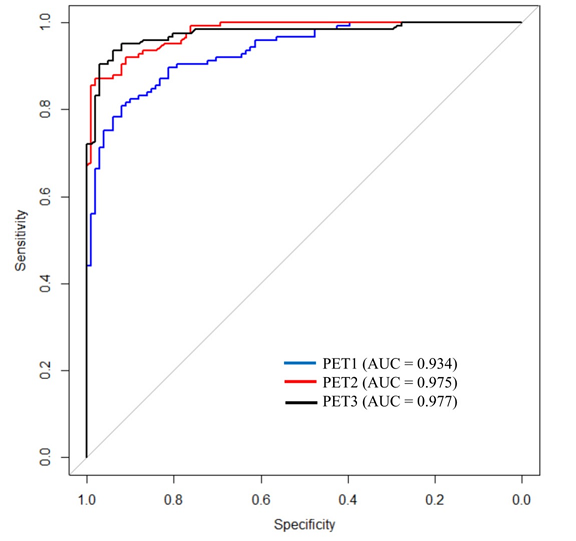글로벌 연구동향
핵의학
- 2022년 06월호
[Cancers (Basel).] Predictive Value of 18 F-FDG PET/CT Using Machine Learning for Pathological Response to Neoadjuvant Concurrent Chemoradiotherapy in Patients with Stage III Non-Small Cell Lung Cancer성균관의대 / 유장, 최준영*
- 출처
- Cancers (Basel).
- 등재일
- 2022 Apr 14
- 저널이슈번호
- 14(8):1987. doi: 10.3390/cancers14081987
- 내용
Abstract
We investigated predictions from 18F-FDG PET/CT using machine learning (ML) to assess the neoadjuvant CCRT response of patients with stage III non-small cell lung cancer (NSCLC) and compared them with predictions from conventional PET parameters and from physicians. A retrospective study was conducted of 430 patients. They underwent 18F-FDG PET/CT before initial treatment and after neoadjuvant CCRT followed by curative surgery. We analyzed texture features from segmented tumors and reviewed the pathologic response. The ML model employed a random forest and was used to classify the binary outcome of the pathological complete response (pCR). The predictive accuracy of the ML model for the pCR was 93.4%. The accuracy of predicting pCR using the conventional PET parameters was up to 70.9%, and the accuracy of the physicians' assessment was 80.5%. The accuracy of the prediction from the ML model was significantly higher than those derived from conventional PET parameters and provided by physicians (p < 0.05). The ML model is useful for predicting pCR after neoadjuvant CCRT, which showed a higher predictive accuracy than those achieved from conventional PET parameters and from physicians.
Figure 1. comparison of the ROC curves of the ML models according to the included PET data. It showed that the AUC of ML using PET/CT data obtained after neoadjuvant CCRT was significantly higher than that of using only baseline PET/CT data。
Affiliations
Jang Yoo 1 , Jaeho Lee 2 , Miju Cheon 1 , Sang-Keun Woo 3 , Myung-Ju Ahn 4 , Hong Ryull Pyo 5 , Yong Soo Choi 6 , Joung Ho Han 7 , Joon Young Choi 8
1 Department of Nuclear Medicine, Veterans Health Service Medical Center, Seoul 05368, Korea.
2 Department of Preventive Medicine, Seoul National University College of Medicine, Seoul 03080, Korea.
3 Department of Nuclear Medicine, Korea Cancer Center Hospital, Korea Institute of Radiological and Medical Sciences (KIRAMS), Seoul 01812, Korea.
4 Division of Hematology-Oncology, Department of Medicine, Samsung Medical Center, Sungkyunkwan University School of Medicine, Seoul 06351, Korea.
5 Department of Radiation Oncology, Samsung Medical Center, Sungkyunkwan University School of Medicine, Seoul 06351, Korea.
6 Department of Thoracic and Cardiovascular Surgery, Samsung Medical Center, Sungkyunkwan University School of Medicine, Seoul 06351, Korea.
7 Department of Pathology, Samsung Medical Center, Sungkyunkwan University School of Medicine, Seoul 06351, Korea.
8 Department of Nuclear Medicine, Samsung Medical Center, Sungkyunkwan University School of Medicine, Seoul 06351, Korea.
- 키워드
- 18F-FDG PET/CT; machine learning; neoadjuvant concurrent chemoradiotherapy; non-small cell lung cancer; pathologic complete response; random forest.
- 연구소개
- 제3기 비소세포성 폐암 환자에서 선행 항암방사선치료 (neoadjuvant concurrent chemoradiotherapy)의 병리학적 완전 관해 (pathological complete response)는 예후예측에 매우 중요한 변수입니다. 이러한 치료 반응을 평가하기 위해 본 연구진은 기계학습을 적용하였으며, 기존의 PET/CT 변수 및 의료진들의 정성적 판독들과의 성적을 비교하였습니다. 총 430명의 환자를 대상으로 선행 항암방사선치료 전과 후에 18F-FDG PET/CT를 진행하였으며, 원발 종양에서의 texture feature를 측정하였습니다. 정량적 변수들을 random forest를 이용하여 병리학적 완전 관해를 예측하는 성적을 구하였습니다. 기계학습을 이용한 예측 성적의 정확도가 93.4%를 보였고, 기존의 PET/CT 변수들의 정확도는 70.9%, 의료진들의 성적은 80.5%를 보였습니다. 기계학습의 정확도가 통계적으로 유의미하게 높은 결과를 보였습니다. 따라서, 선행 항암방사선 치료에 대한 병리학적 완전 관해를 평가하는데 있어서 기계학습을 적용함으로써 예측 정확도를 높일 수 있습니다.
- 덧글달기
- 이전글 [Eur J Nucl Med Mol Imaging.] Incidence rate and factors associated with the development of secondary cancers after radioiodine therapy in differentiated thyroid cancer: a multicenter retrospective study
- 다음글 [J Pers Med.] Prognostic Value of Dual-Time-Point [ 18 F]FDG PET/CT for Predicting Distant Metastasis after Treatment in Patients with Non-Small Cell Lung Cancer







